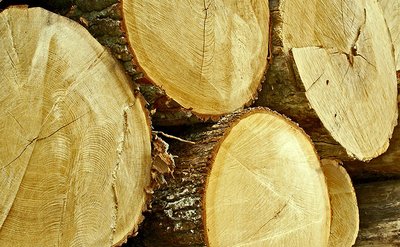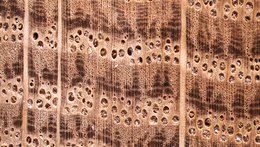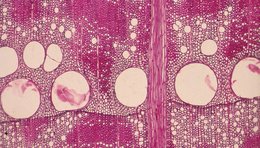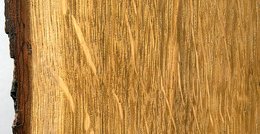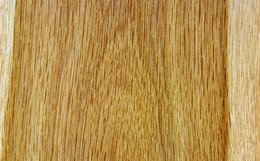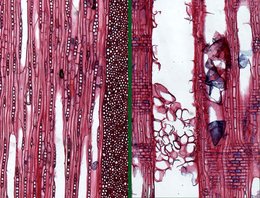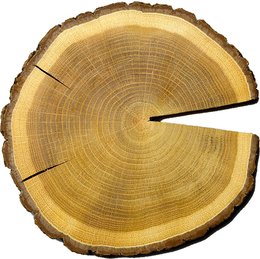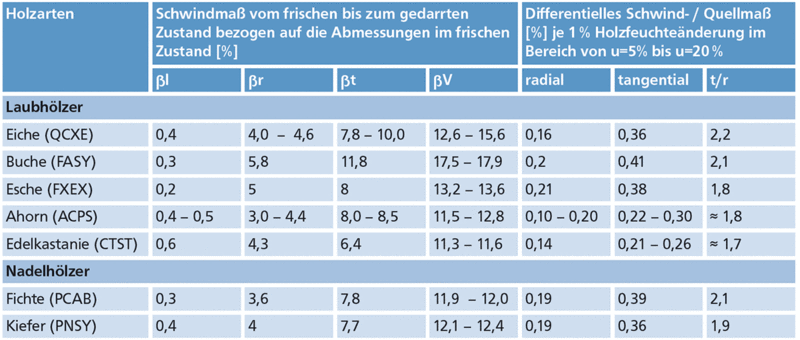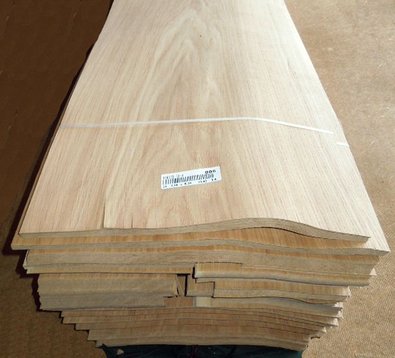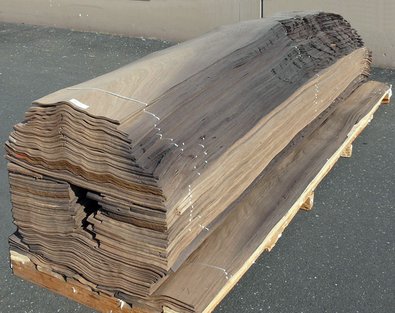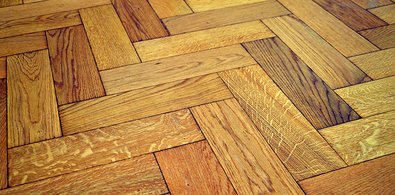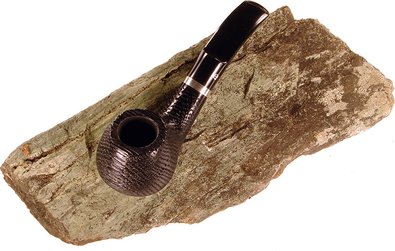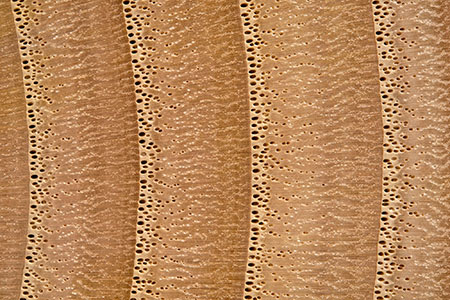The sessile oak (Quercus petraea) was the tree of the year for 2014 and like English oak (Quercus robur) it also belongs to beech family (Fagaceae). Since there is no reliable way to differentiate the wood of both oak species from one another - neither macroscopic nor microscopic for every single differentiating feature- the names of both species will be summarized here on simply as oak.
Description of the wood
The oak possesses a regular coloration of the heart wood ("heartwood tree") with more or less a regular differentiation in color between heart and sap wood. The sapwood range is relatively narrow (usually 2.5 to 5cm wide and is yellowish-white to light-grey (Figure 1). The heart wood is bright or honey yellow, grey-yellow to bright brown and darkens under the influence of light from yellow to dark brown.
Freshly cut oak wood has an acidic smell which arises due to the high percentage of vegetable tannins (on average 6% in the wood and 10% in the bark). The pH-value lies around 3.9.
Oaks belong to the ring-porous wood species which is recognizable in the cross section on the closed spring-wood pores and on the longitudinal surfaces in the cathedral effect (tangential) and silver grain (radial). There the large vessels of the spring-wood can be seen with the naked eye and can be felt as small "pin holes". The vessels of the summer-wood in comparison are noticeably smaller and can hardly be recognized as a single cell and arranged on the cross section in small, bright radial sections (Flame tracts -Figures 2 and 3). In heartwood, the early-wood pores are substantially clogged with tyloses (Figure 6). As a result, the sapwood displays low levels of treatability on the one hand but is hardly permeable to liquids on the other.
The macroscopic structural features of oak can be easily identified with a transmitted light microscope (Figures 3 and 6). The cross-section shows the vessels of the early and late wood, thick-walled fiber base tissue and axial parenchyma arranged in short tangential ribbons. The cell width of the wood rays is clearly visible on the tangential section. The radial section shows vessels with simple vessel breaches, tyloses and the alternate arrangement of the vascular pits.
Very wide and narrow single-rowed wood rays are irregularly arranged on the longitudinal surfaces (Figures 4 and 5). The wide rays are easy to see in the radial section as smooth and shiny bands which gives the wood a particularly eye-catching appearance. Figures 4, 5 and 7 show the difference in color between the sapwood and heartwood of oak.
Over-all character
Decorative ring-porous broadleaved species with a wood coloration from yellow-grey to bright brown. Over time it can darken to a dark yellow-brown. The borders of the growth rings are distinctly separate from one another and the coarsely porous earlywood ring-pores on the longitudinal surfaces can be seen as an attractive "cathedral effect" or stripes.
Characteristics
Oak wood is a very hard and heavy broadleaved tree species with a density of 0.71 g/cm3 at a moisture content between 12-15% (Table 1). Oak possesses excellent strength properties and a high resistance to wear (Table 2) due to the high density and wood anatomical structures. The bending strength of oak is 95 N/nm2 and lies under the values for ash and beech, but on the same level as maple.
Oak posses a higher level of elasticity and has better results for pressure resistance and bending strength. In comparison with the ring-porous and macroscopically similar wood of the horse chestnut (Castanea sativa). The surface hardness lies in a similar range as ash and beech wood. The year-ring width of the deciduous ring-porous species has an influence on the mechanical-technological wood characteristics. With an increase in year-ring width there is an increase in the percentage of late-wood an well as an increase in density.
It is commonly spoken about "mild" and "hard" oak wood. The first characterizes itself by a high proportion of narrow growth-rings and is a fine, slow growing wood. "Hard" oak is in comparison a coarse, quickly growing wood with wide growth-rings. The sessile oak leans more towards the "milder" wood than the English oak. Oak must be dried very gently since it not only tends to crack and warp but can also display unsightly discoloration.
In a radial direction oak has a measure of swelling of 0.16% for every 1% change in wood moisture content and thus lies under the values for beech and ash as well as spruce and pine (Table 3). The ratio for the relationship of tangential to radial shrinking and swelling from oak wood is larger and more unfavorable than those of the above mentioned tree species. In general, the oak possesses good dimensional stability. Shrinkage decreases with an increase in the narrowness of growth rings.
Oak wood can be easily and cleanly processed with all tools and the surfaces can be treated without a problem. Oak stained with ammonia is called "fumed oak". The fuming of the wood was used earlier to protect against fungus and insects, however, today its demand arises for aesthetical reasons. Variations in color can be achieved in all shades from a bright natural brown to black-brown. Further surface effects can also be achieved by the use of a satin finish or white washing.
The heartwood of oak has a high natural durability. However, the classification into the durability class (DHK) °2 has been controversial for a long time. Results from various experiments suggest a lower durability. Underwater and in anaerobic conditions oak is considered to last almost indefinitely.
Oak has a corrosive effect on ferrous metals in combination with moisture and under the influence of oxygen. Conversely, the reaction of iron with the substances contained in oak wood causes blue-grey to black discoloration. This effect can also be observed with moor oak. Moor oak can still be sawn, planed, milled, drilled, ground and turned/sliced into veneers since storage times in the soil, even over 7,000 years, have not led to any significant changes in the mechanical properties and sorption behavior of the wood.
Field of application
Oak is marketed as round wood, cut lumber and veneer. The wood is very versatile due to its good strength properties as well as its decorative appearance.
Oak has a long tradition as a wood for joiners or as a finishing and furnishing wood. It is a perfect choice for frameworks, doors and gates as well as parquets and plank flooring (Figure 10). Oak is one of the most important wood species for parquet. Furthermore windows (Figure 11), stairs (Figure 12), ceilings and wall paneling as well as fittings are still manufactured from oak. It is also used in the production for furniture, in particular for tables and chairs. Both veneers (Figure 8) and solid wood are used. Even high-quality coffins are traditionally made of oak.
As a construction timber, the oak is particularly well suited for structures with high demands (e.g. for exterior structures in earth, bridge and hydraulic engineering. The construction of vehicles, wagons and containers is one of the numerous uses for oak in addition to boat and shipbuilding. Oak is also used for special applications such as silo and mill construction as well as mechanical engineering. In gardening and landscaping the oak serves well as fences, decks, wooden pavement, palisades and as pedestrian bridges.
In addition to the sweet chestnut, oak fulfills the high demands of the cooper trade since barrels and other containers for liquids are made from this wood. Whisky lactone can only be detected in oak wood and plays a large role in the aging of wine in wooden containers. As such, it belongs to the most important aromatic substances of oak wood but is largely absent in the pedunculate oak. Whisky lactones are a distinguishing attribute of the sessile oak. Their proportions vary greatly depending on their origin.
In the past, half-timbered houses were traditionally made of oak. Today, more slim and architecturally demanding structures can be built, for example by using oak glulam beams (Figure 15). Since May 2012 the use of oak laminated timbers has been approved for windows plus posts and beams (Figure 16).
Sculptures and imposing altars have been made out of oak for centuries (Figure 13). Artists like Ruben or Rembrandt painted their masterpieces on oak panels.
Oak is an excellent source of firewood. It burns for a long time and has a heating value of 2,100 kWh/rm at 15% wood moisture. The wood burns with a rather small flame.
The oak not only supplies valuable wood, bark for tanning and/or dyeing purposes, but also acorns which are still used as animal feed.

